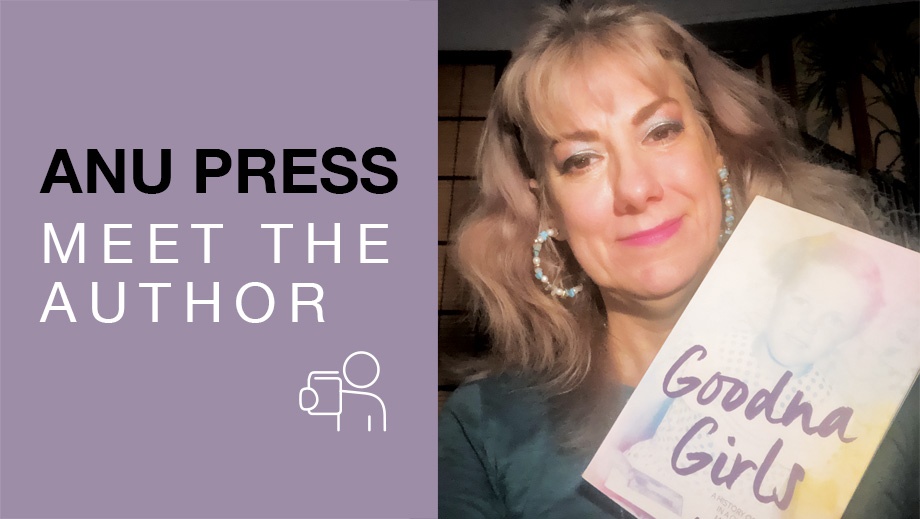Meet the Author: Adele Chynoweth
Adele Chynoweth was a lecturer at the Centre for Heritage and Museum Studies at The Australian National University. She was a secondary school teacher before training as a theatre director and completing a PhD in contemporary Australian drama. She was curator of the National Museum of Australia’s touring exhibition ‘Inside: Life in Children’s Homes and Institutions’. She is the recipient of the 2018 Vice-Chancellor’s Award for Public Policy and Outreach. In 2020 she was awarded the Medal of the Order of Australia for service to public history.
Your latest book Goodna Girls tells the heartbreaking stories about the children incarcerated in Wolston Park Hospital, an adult psychiatric facility in Queensland. What drove you to research and write this book?
The women whose personal narratives are featured in the book asked me to help them ‘get justice’. I met them through my work as co-curator at the National Museum of Australia of the exhibition ‘Inside: Life in Children’s Homes and Institutions’, commissioned by the Rudd Government. I learned that when working with community groups, especially with those who are vulnerable, you can’t just use them for their stories and objects and then walk away after the exhibition launch. You have to give back.
Can you take us through the process of writing this book? What challenges did you face?
Writing the book was only one part of my work with these survivors. I also liaised with journalists. I wrote an opinion piece. I travelled to Queensland and met with members of the Queensland Legislative Assembly. I worked unremunerated for over five years to help these women ‘get justice’.
And there was so much talking with professionals whose sector had intersections with this living history. Talking. Talking. Talking. Talking. And not much listening. And the scraps of listening vanished. So, the book was about putting this all on the record. Forever. To stop the fobbing off. So that this vital narrative would not be forgotten when the telephone handset or the cup of tea was laid to rest.
The challenge I faced in writing the book was a middle-class-centric protocol from the relevant human ethics research committee. Getting ethics approval for my research and conducting research professionally means a lot to me. But the committee said that a psychologist had to be present in my research interviews. Now I know that the welfare of the women was crucial, but you can’t dictate what is good for them. They’ve had do-gooders doing that all their lives. You have to respect their agency and their ability to articulate what support means for them. And you have to understand that mental health professionals, when these women were children, were the oppressors. So, for a university human research ethics committee to insist on a psychologist being present when those women related their personal history to me was the emotional equivalent of an informant from former East Germany talking to a researcher in the presence of the Stasi.
It took months of negotiation before I could persuade the human research ethics committee to endorse a mode of support that the women would agree to. And I thank the committee for listening. It all worked out in the end.
The personal stories in Goodna Girls are traumatic and powerful. Was it hard to write these stories, and how did you manage to combine the responsibility of telling these emotional stories while maintaining your objectivity as the researcher?
There is no such thing as objectivity or neutrality. We all inhabit subject positions. The spreadsheet of numerical data depicts a narrative that may have as much emotional impact as a survivor of child abuse who relates her oral history.
But there is such a thing as rigour. Widening the methodological scope. I undertook archival research – government records (policy documents of the day, meeting reports) and the survivors’ personal, institutionalised records (medical staff aren’t always objective, just to be clear). I also interviewed staff witnesses from Wolston Park Hospital and read the research of others.
And yes, it was emotionally hard to write. But harder still to walk away and do nothing. And I can experience my feelings and think critically at the same time. I trust that the reader of Goodna Girls will do the same.
Why do you believe this history is important to tell? What impact has your research had, and what do you hope it will further achieve in the future?
The history needs to be told so that it doesn’t remain as the Queensland Government’s dirty secret. The history needs to be aired with respect and scaffolded by meticulous research so that it isn’t confined to urban mythology, sensationalist gossip, voyeurism, the site only being the subject of commercial ghost tours, etc. This history is about conscious and systemised government policies that had tangible and long-lasting effects on real women in our lifetime. The Queensland Government needed to come clean on all that.
The research led to long-overdue reparation by the Queensland Government through ex-gratia payments to those State Wards who had been wrongly placed in psychiatric institutions. But many survivors died before they could see the outcome. Goodna Girls is also a memorial to them.
What I still hope for is that the Queensland Government will formally acknowledge the book. The Queensland Mental Health Commission at least need to do that. Their former acting Commissioner contacted me about my research. Public history supports public health – there is significant research that validates this and so and they need to recognise those in the community beyond their own bureaucratic circles who support crucial social change through researching history and making it publicly available.
I also hope that the book will help realise an inclusive child welfare history. Goodna Girls is set against the backdrop of Australia’s out-of-home ‘care’ system in the 20th century. It is a history of the Stolen Generations, Former Child Migrants and the Forgotten Australians. But sadly, our university and school curricula as well as museum galleries, for example, do not acknowledge all three groups. It is divisive, cruel and re-traumatising. That needs to change – now – so that all survivors can benefit from much-needed recognition, in their lifetime. This is urgent.
Congratulations on being shortlisted for an Educational Publishing Australia Award. What an incredible achievement. What was your reaction when you found out?
Huge thanks to ANU Press!! So two reactions: gratitude (after the shock had work off) and a sense of vindication on behalf of the survivors. For years and years, they had been fobbed off, disbelieved or, at best, received mere tokenist responses. Gaslighting and breadcrumbing. But now, with this acknowledgement, their struggle has been validated and located firmly within Australian history.
Why did you choose ANU Press to publish this book?
ANU Press’ Aboriginal History editorial board comprises esteemed scholars who understand the intersections between Indigenous and non-Indigenous narratives, which is such a crucial part of Goodna Girls. ANU Press also provides open access to the e-book, which is really important – that’s social justice, right there.
So that’s why I chose ANU Press initially, but then I learned that there are additional benefits. The peer-review feedback on my manuscript was thorough, rigorous and informed by acute understanding of the premise. Oh, to be understood!! Teresa is such an amazing graphic designer. I gasped when I saw her idea for the cover. She had captured the spirit of the women in the book. Rani Kerin is an extraordinary, gifted and generous copyeditor. The entire ANU Press core staff have been on board from the beginning. ‘Thank you’ never seems enough. The professionalism of ANU Press is absolutely exemplary. You asked if writing the book was hard. Yes, it was but publishing with ANU Press was healing.
What is next for you?
In my role as writer, producer and director, I am working with Ronin Films on finalising the production of a documentary film.




